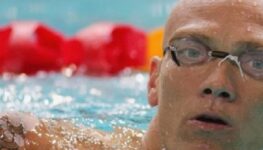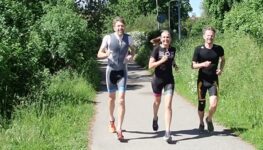Big Gear Work – Low cadence / High Torque
If you are part of the MoT squad, attended one of the MoT camps or read our past articles, you will know we advocate the use of low cadence / high torque training. We call it STOMPing.
Each week, we prescribe our athletes with a dedicated STOMP session (between 40-50rpm), similar to the ones featured in this earlier article about developing strength (muscular endurance) in the swim, bike and run training.
But we don’t limit exposure to low cadence work to just one session per week, “soft” STOMPing (55/60rpm) is featured in other weekly sessions too.
The pure STOMP sessions are an exaggeration of what you would ordinarily face in racing (apart from on the most extreme climbs), whereas soft STOMPing may well be utilised regularly when on hilly / rolling hill courses.
The other benefit of STOMPing is that it allows the athlete to develop their downward pushing action, while reducing the ability to “scuff under” and pull up on the pedals. Pushing down primarily uses the glutes and quads (we call these the “bike muscles”), scuffing under and pulling up uses the calves, hamstrings and hip flexors (the primary “running muscles”). Read more here as to why this is important, and we DON’T want triathletes using the run muscles on the bike.
Graeme Obree was well known to be a STOMPer, committing to doing huge amounts of low cadence / high torque work, even making a custom home trainer combining a washing machine and leather belt!! Note his “big” gears

Podcast referral – Fast Talk
As we have done previously, we are providing a resource from an external source that repeats our reasoning, rephrases the reasons or is maybe introducing you to the concept of “low cadence / high torque” training on the bike. Here are some key take away points:
But first:
“Torque (also known as moment, or moment of force) is the tendency of a force to cause or change the rotational motion of a body. It is a twist or turning force on an object. Torque is calculated by multiplying force and distance.”
- Very popular amongst world class coaches * (cycling and triathlon) but has very little “science” supporting its benefits.
* The mainstream coaching community / cycling world still largely emphasises high cadence / low torque cycling – pedaling at 90+ rpm
- Low cadence / high torque studies are hard to regulate, which is why so little “science” exists. Low cadence cycling is categorised differently depending on who you talk to; 50-60rpm, 40-50rpm, 0-45rpm, or anything below 80rpm.
- MoT uses a low cadence approach all the time, we recommend our male athletes stay below 75rpm and our female athletes stay below 85rpm.
- STOMP sessions range between 40 and 60rpm
- Low cadence work doesn’t align with power calculations – low cadence work means that power levels will be “low”, because the velocity of the pedal revolution is low
- Force applied to component x Velocity of component = Power in watts
- Low cadence work can assist with many training adaptations – aerobic through to VO2Max
- Low cadence work for triathletes to be seated
- Think “break my bike” – need to be aggressive, GRIP IT AND RIP IT
- Top cyclists (and triathletes) do HUGE volumes of low cadence cycling, scientists HAVE assessed data collected and noted this, even if they cannot “prove” why low cadence training is beneficial
- Science is behind because there are too many variables that science projects cannot control
- Low cadence / high torque work has been shown to recruit more muscle fibre types – fast twitch (type 2B), interim fibres (type 2A) and slow twitch fibres, and helps to train the type 2 A and B fibres to become more aerobically conditioned – meaning they can perform for longer
- Fat adaptation can be trained, working hard while being aerobic, not tipping into using stored glycogen stores
- Ones VLamax can be lowered, in fact, low cadence / high torque is the most effective strategy for doing this.
- Low cadence / high torque work (<60rpm) recruits more of the hip musculature, whereas high cadence / low torque loads up the knee musculature.
- Healthier and more effective use of the big muscles in the pedal action
- Low cadence / high torque lowers the cardiac / respiratory stress, good for beginners, over-trained and injured athletes
- Focus on cycling movement and body action:
- using the glutes when at lower cadences, not the thighs/knees
- keep the spine “flat” (not rounding it – leaning backwards)
- watch the knees – tracking straight or slightly inwards
- we advocate a use of the upper body too, in timing with the leg actions – one arm engaging while the opposite legs pushes, creating torque through the body
- “Grip it and rip it” – Brett Sutton
- small amount of sway is OK 👌

- Everyone is more efficient (aerobically) at lower cadences (40-80rpm) – VO2Max testing shows this
- All low cadence / high torque sets (if not all training!) should be done in race day position – aerobars! So, stay aero when STOMPing or recovering or on a relaxed cool down!
- The podcast hosts do discuss strength training, in gyms, with barbells/leg press machines, but we do not, as we are:
- coaching triathletes, not track cyclists / cyclists (swim training and run training also needs to be factored in)
- introducing the concept slowly and adjust to the feedback and needs of each athlete, so they can develop strength and efficiency over time
- if any “niggles” are felt STOMPing it has always been due to past (chronic) injuries or wear and tear from something else (running, gardening, etc) that is felt in all lower body movements – but not from STOMPing itself.
- A common sensation / niggle felt on the bike is calf strain, caused by scuffing under / pulling up on the pedals, this is why we also emphasis “STOMPing”, to push down only, NOT to scuff or pull to try to get a 360° pedal action (using the run muscles)



